There’s no better time to draw conclusions and get ready for 2018 than December, a month of celebration and reviews regarding the year that is passing away. Adopt this tactic and avoid getting cold feet in January, having already done your homework and knowing your goals.
Given that a lot has happened this year and that we also love to analyze and discuss the results, we thought there’s no better way to do that than seeing the gifts Santa Google brought in 2017.

So we scooped, searched, and chose the most significant updates and announcements Google has made in the SEO landscape, updates that influenced and will always influence rankings. This is what we’ve found so far:
- The Intrusive Mobile Interstitials Update Is a new Ranking Signal
- Google Introduced the Mobile-Friendly Test API
- Emojis Started to Show up Again in the Search Results Snippets
- Google Has Rolled out the Google Assistant to More Devices
- Officially, the Duplicate Content Penalty Myth Was Broken
- Fred, the New Update, Created Massive Ranking Fluctuations in SERP
- “Upsetting-Offensive” Content Flag Is Rolling out to Offer Qualitative Results
- Google Site Search Is Out. Custom Search Within Site Is the Alternative
- Google Search Console’s Metrics Got Integrated Into Google Analytics
- Google introduced “Project Owl” – The Shield for Fake News
- Fetch as Google for Mobile Apps Is Removed To “Avoid Unnecessary Duplication”
- Baidu, Sogou, and Yahoo Japan Adopted the Mobile Framework (AMP)
- Google Begins Mobile-First Indexing by Moving M-Dot Site to Responsive
- Chatbot Marketing – a Strategy for the Future
- Dwell Time – on Its Way to Become a Ranking Factor
- Conclusion: What to Expect in the Future of SEO
JANUARY
1. The Intrusive Mobile Interstitials Update Is a new Ranking Signal
At the beginning of this year, people got nervous and concerned with the news of an update meant for Intrusive Mobile Interstitials. On January 10 sharp, experts in the SEO industry saw a drop in site traffic, besides some other important changes that Google has made. They were right! A new update happened.
At that time, we talked about this update in a blog post since we wanted to see exactly whether a site might be at risk, what the experts say about the interstitials impact on SEO comparing with Google’s statements, and, eventually, how to prevent getting hit by a penalty.
The Intrusive Mobile Interstitial Update came in 2015, after Google announced they would downgrade sites that show annoying full-page ads prompting users to install mobile apps. Since the Algorithm went live, Google hasn’t made any big changes but kept an eagle eye on the intrusive advertising formats available on the web that offered a negative user experience.
Along with this update, penalized websites started to quickly appear.
Google stated that this signal is a ranking one:
| As we said, this new signal is just one of the hundreds of signals that are used in ranking, and the intent of the search query is still a very strong signal, so a page may still rank highly if it has great, relevant content. | |
The Rater Guidelines were updated. In the Distracting/ Disruptive/ Misleading Titles, Ads, and Supplementary Content chapter it was explained which interstitials will be penalized. It includes the ads that actively float over the main content or an interstitial page which redirects the user away. Basically, ads that block the user accessing the main content.
2. Google Introduced the Mobile-Friendly Test API
The API launch for Mobile-Friendly Test on January 31 was regarded as big news. This year, Google did a lot of changes and improvements for mobile users. We can easily see it, given the fact that they’ve created a Mobile-Friendly Test available within an API.
The API method allows all mobile device users to check individual pages automatically. Before the API version, the only way was the manual input. Another advantage is the fact that, after running the tests, the method includes a list of all the blocked URLs.
Besides that, the Mobile-Friendly Test hasn’t suffered any other big or worthy of mention changes.
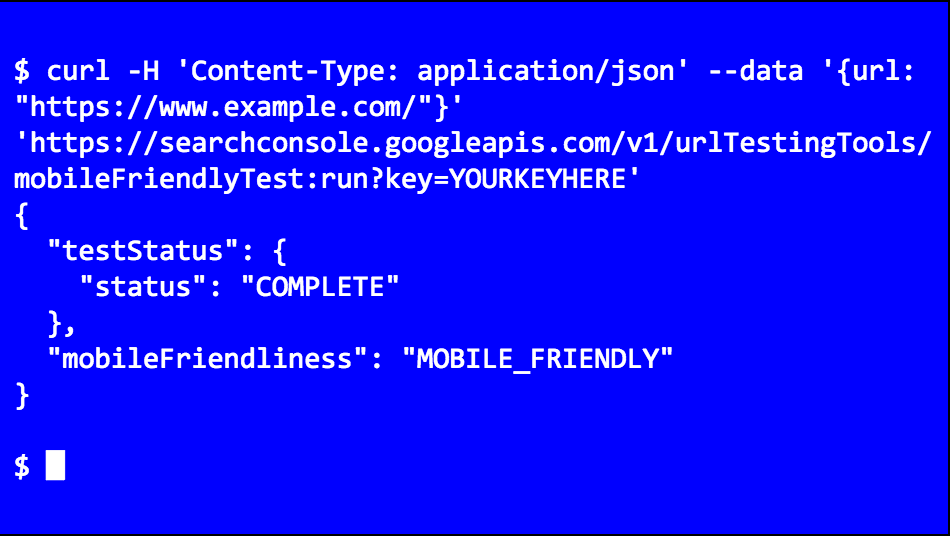
The API key code for the Mobile-Friendly Test
Source: Google Webmaster Central Blog
The documentation used simple steps anybody could follow so to get the API. More information about the API and how to implement it are available on Google Developers. Or you can search answers and get live help on Webmaster Help Forum.
FEBRUARY
3. Emojis Started to Show up Again in the Search Results Snippets
After Google’s decision to remove characters from the search engine results back in 2015, now it brings back the emojis.
Now they can be found everywhere. In other words, for some of us, they became a part of our life, always helpful in our communication. They can be found on mobile phones, social channels, emails, or pictures if you like. They can easily pass the language barriers.
Emojis are excellent for captivating attention and for making the text livelier, giving emotions to our words. You know the saying “a picture’s worth 60,000 words” – that goes for emojis too since they are a visual representation. People remember 80% of what they see and only 20% of what they read.

Google made a statement regarding this change and said:
| We can confirm that we have added a feature to our snippets to feature emojis where relevant, useful, and fun. You’ll see them crop up across various snippets moving forward. | |
The questions that pop out are why they took this decision, whether the emojis will stay for good or not, and how they will improve our search results. An investigation further into this is worth taking. Something we’ll have to look into in 2018.
The interesting thing you could easily search on Google using emojis. We tried playing along with this to see the results comparing the standard search.
We searched for “Kristen Bell” and “Kristen ?” and we did that for multiple singers, actors and bands to spot the differences. As you could see in the next screenshot, there are some differences.
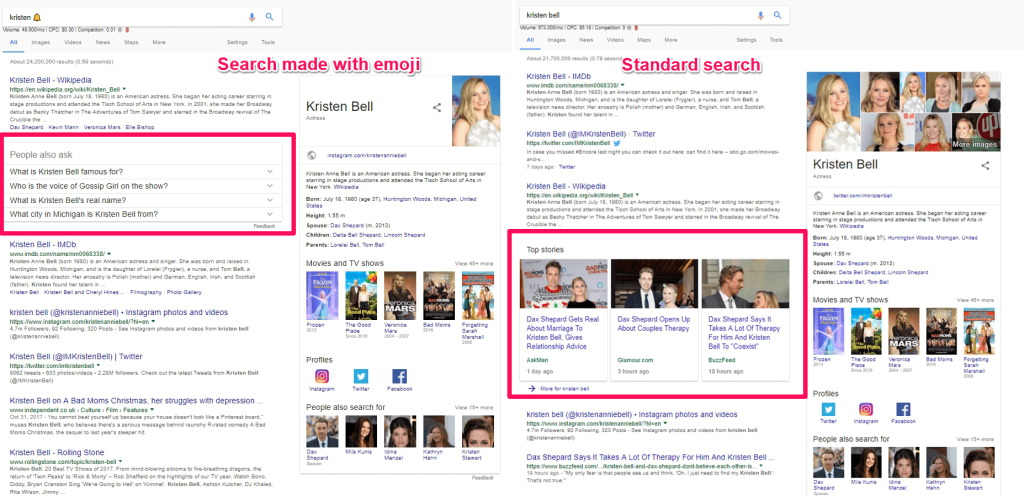
The results are twisted from a query search to another. As you can see in the first screenshot, for the emoji search, Google offers you some suggestions for other queries. In the standard search, where we use text only, we can see there is also some news displayed, together with more pictures of the actress.
There is not an improvement in the emoji search, but there is something to look further into. Google tries to deliver what the user needs, and since this is the time of Millennials, why not offer results for this niche?!
4. Google Has Rolled out the Google Assistant to More Devices
Google Assistant, the virtual personal assistant developed by Google was launched in May 2016. At first, it was available only on the Pixel smartphone, Android Wear, Google Home, and its messaging app Allo.
In February, Google announced that they will make it available for Android smartphones too, but only for newer smartphones, meaning Android 6.0 and 7.0.
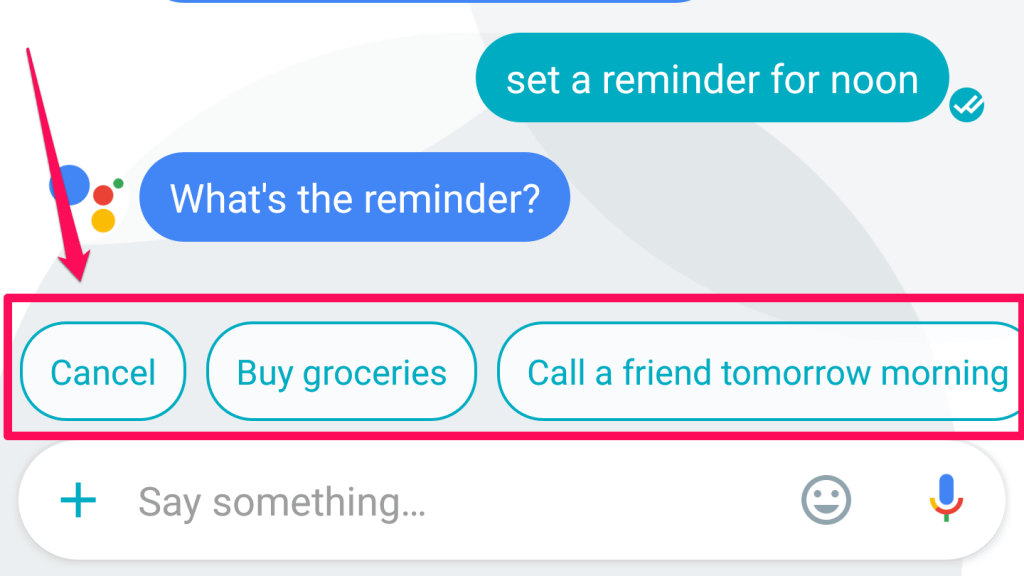
This was a step up because Google Assistant can become in handy for finding what you want online at a faster loading speed and with a more accurate precision. Google is trying to making it easier for users to access the information with shorter actions/taps.
In the future Google Assistant aspires to be conversational and go beyond simple voice query input and text-to-speech playback.
We have to mention that in one Webmaster Central Hangout it was disclosed that PASO might be the future of SEO due to the fact that it offers personalized information for each user. PASO comes from Personal Assistant Search Optimization.
MARCH
5. Officially, the Duplicate Content Penalty Myth Was Broken
Duplicate content: a never-ending topic of discussion.
March was a busy month. It started with debunking a myth: the duplicate content penalty. It was recorded in March 2017, in the Google Search Quality Evaluator Guidelines, that the copied content is penalized, not the duplicate one:
The Lowest rating is appropriate if all or almost all of the MC (main content) on the page is copied with little or no time, effort, expertise, manual curation, or added value for users. Such pages should be rated Lowest, even if the page assigns credit for the content to another source.
We heard it once from Matt Cutts in 2013, and from Andrey Lipattsev again, in 2016, and we can see it written in black and white in the Google Search Quality Evaluator Guidelines. Google has a different approach to dealing with copied content than with duplicate content. Duplicate content doesn’t get you penalized, while copied content does.
6. Fred, the New Update, Created Massive Ranking Fluctuations in SERP
Back in March, another big change that shook the SEO landscape was the new update named Fred, still unconfirmed at the moment:
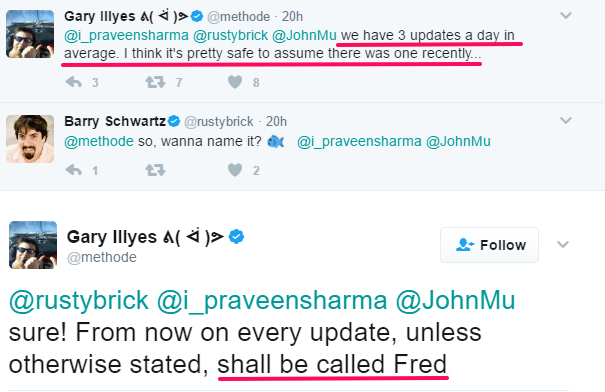
The first ones to notice some strange activity were WebmasterWorld and Black Hat World. Then the experts took the matter into their own hands and started to debate the possible existence of an update. There was a thread started on Twitter and SEO forums on this matter.
A lot of people experienced some weird search engine ranking position (SERP) fluctuations.
After a quick search on cognitiveSEO Signals we could see that after the unconfirmed update, the volatility was high. In the next screenshot, there is a visual representation of what happened in SERP at that time. The orange line shows a medium volatility and the red one represents a high volatility.

7. ‘Upsetting-Offensive’ Content Flag Is Rolling out to Offer Qualitative Results
Since with the bad effect of the fake news, Google started taking action into offering correct and relevant information to the user, as he tried numerous times before. That’s how the idea of the ‘Upsetting-Offensive’ content flag was born.
Even so, Paul Haahr, ranking engineer at Google, said that:
| They’re explicitly avoiding the term ‘fake news,’ because it is too vague. | |
| Paul Haahr | |
| Ranking engineer at Google | |
Google hired over 10,000 search quality raters worldwide to evaluate the search results and assess the quality of a website based on Google General Guidelines.
Below you can see an example of an article that is flagged for “Upsetting-Offensive” content:
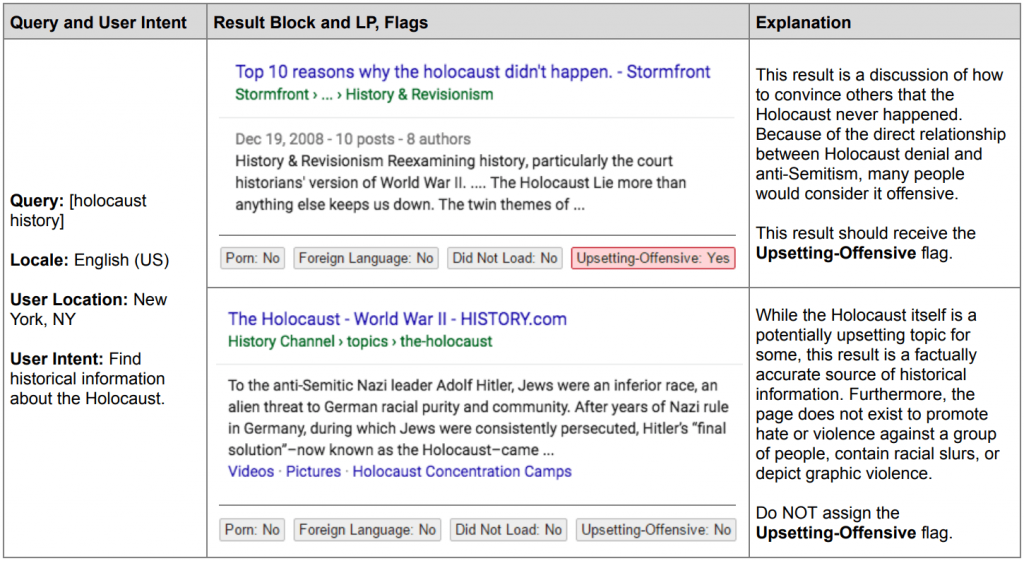
APRIL
8. Google Site Search Is Out. Custom Search Within Site Is the Alternative
A question popped-up during a Google Webmaster Central Hangout about shutting down Site Search and whether it’s going to impact sites.
John Mueller said the implementation is different for those two. If you perform a search using those tools you might find different search results. Below you can see a wrap up of the differences between Google Site Search and Free Custom Search:
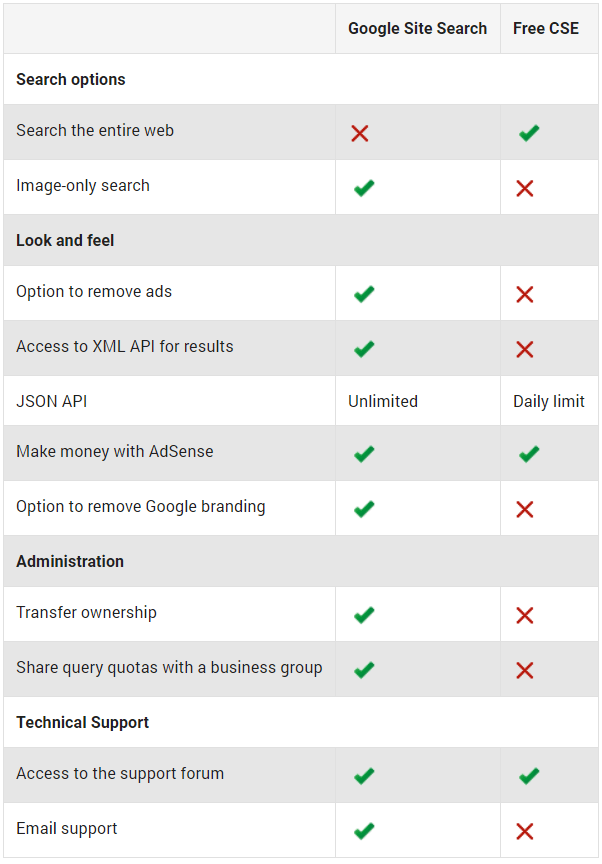
Google Site Search will combine with Custom Search because they almost do similar things. Site Search is used for one website and Custom Search can be both used on different sites, and on one only.
Google announced on Google Enterprise Search that the process of shutting down Google Site Search started in April 2017 and will be finished in April 2018.
MAY
9. Google Search Console’s Metrics Got Integrated Into Google Analytics
In May, Google announced another improvement: the integration of Search Console in Analytics along with support and guideline on the configuration.
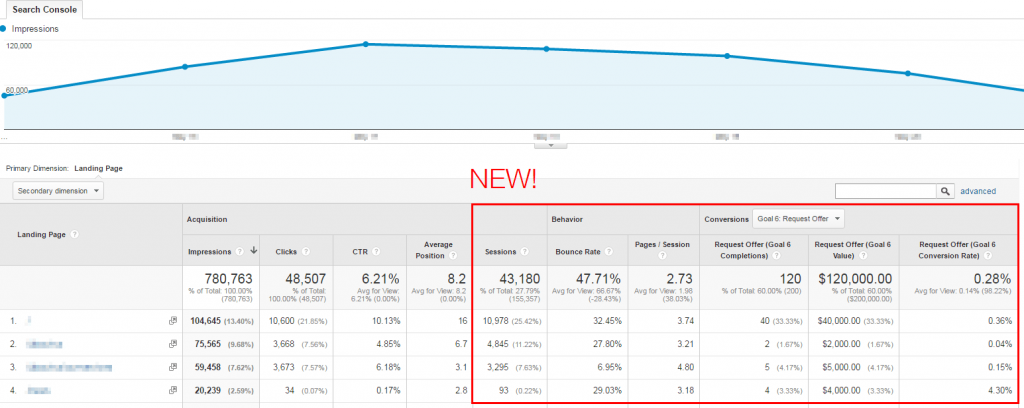
Google Search Console helps webmasters manage the way their websites appear in SERP while Google Analytics helps users to integrate services like Webmaster, Adwords, and other tools to see results based on the source (paid search, organic search result).
In the old version, you could only see how users came on the website and not what they did once they got there. Now, with the next improvement, webmasters can see all the metrics in one place and make decisions based on the data combined with those two tools.
10. Google introduced “Project Owl” – The Shield for Fake News
“Project Owl” is an internal name used by Google. It was designed to improve the quality of search after the big fake news on the presidential nomination in the USA last year. The idea of an owl as a symbol of wisdom is appropriate.
After that event, the public asked for a solution from search engines and social media giants to tackle ‘fake news’ and any other misinformation available on the internet. This project encourages white-hat SEO in general and addressed fake news and heavily-biased content in particular.
The sites to be spotted by Google for having fake news for the first time will be counted as violating the first amendment. But the second time they’ll be marked as bias to specific news/media sources.
SEPTEMBER
11. Fetch as Google for Mobile Apps Is Removed To “Avoid Unnecessary Duplication”
In September Google announced on Google+ that they’ll begin to remove app indexing features from within Google Search Console.
| In May 2016, we announced Firebase App Indexing, together with neat testing tools for apps. To avoid unnecessary duplication, we’ll be turning off the old “Fetch As Google for Apps” feature in Search Console. | |
| Google Webmasters | |
Google’s recommendation for making app content indexable is following the Firebase help documentation.
Last year Google focused their attention more on AMP, responsive design, and other technologies over mobile apps.
NOVEMBER
12. Baidu, Sogou, and Yahoo Japan Adopted the Mobile Framework (AMP)
Speaking of AMP, important SEO news for the ASIA market came in November. Accelerated Mobile Pages will be available to over 1 billion people in Asia. The announcement was made by David Besbris, VP Google Search and AMP Project Lead at Google, on his AMP blog.
Baidu, Sogou, and Yahoo Japan joined the team and started supporting the AMP idea. There are a lot of companies that embrace the idea, such as Bing, Pinterest, Linkedin Tumblr, WordPress, eBay, The Weather Company, Eventbrite, Shopify, Fandango, TripAdvisor, Disney, Food Network, and many more others.
According to a study from Google, the average time to fully load a mobile landing page is 22 seconds. Yet, AMP loads a page faster than 3 seconds.
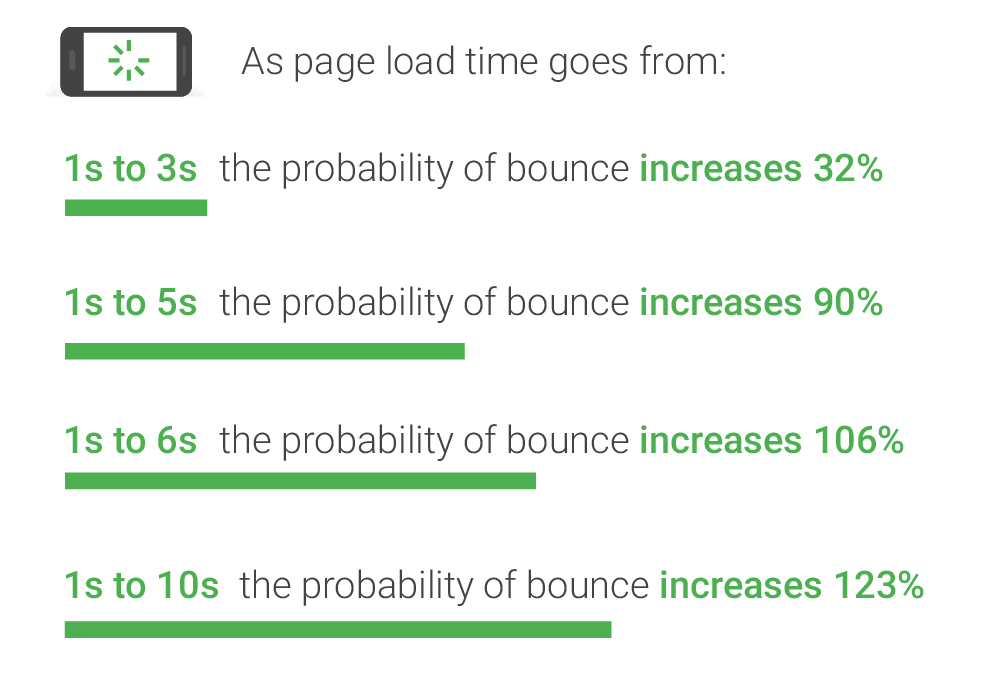
Source: www.ampproject.org
13. Google Begins Mobile-First Indexing by Moving M-Dot Site to Responsive
Google stated in November that they will start an “experiment” and look at mobile content first, instead of the desktop one, in order to decide the ranking of the results. It began testing mobile-first indexing using mobile content for all search rankings.
This change started when Google noticed that searches are more frequent on mobile, yet Google’s index is on desktop pages.
They expanded on the idea in their official announcement on Google Webmaster Central Blog:
| Today, most people are searching on Google using a mobile device. However, our ranking systems still typically look at the desktop version of a page’s content to evaluate its relevance to the user. This can cause issues when the mobile page has less content than the desktop page because our algorithms are not evaluating the actual page that is seen by a mobile searcher. | |
| Google Webmaster Central Blog | |
Since there will be a change, even though we don’t know the exact time, it is recommended that we take a look at the documentation Google provided for moving your m-dot site to responsive.
Something extra, that wasn’t necessarily something Google announced but we debated on our blog and we consider important because they regard the future of SEO, is chatbot marketing and dwell time.
14. Chatbot Marketing – a Strategy for the Future
An interesting idea we debated on our blog this year was the fact that chatbot marketing might be a strategy for the future. To that end, we wanted to see whether it has any impact on SEO or not.
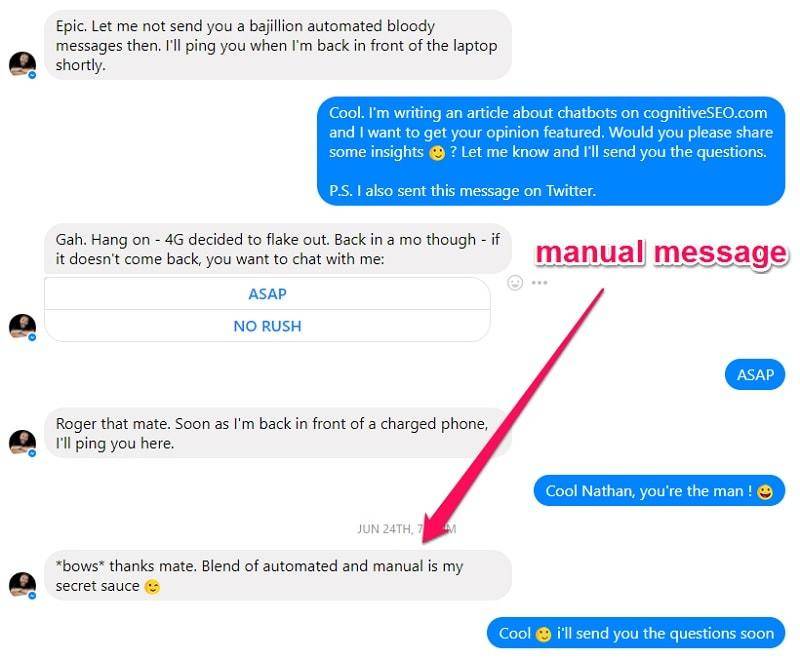
The idea of having a chatbot site is intriguing, but it comes with a cost: the content stored in the database is not indexable.
Sujan Patel advises us to stick to conventional SEO. Even so, chatbots attached directly to your website can bring some SEO advantages. Dwell time and bounce rate are linked to rankings. Improving them can also grow your position in Google.
Also, chatbots can indirectly help you perform link building, likes, and shares. This is a topic that deserves to be taken into consideration for further investigation.
15. Dwell Time – on Its Way to Become a Ranking Factor
Speaking of dwell time, we debated this topic in one of our blog posts. The question was “Is dwell time a ranking factor?”.
At the moment we know that content, links, and RankBrain are rankings factors.
But what is the future of SEO, if it is not the links? User engagement is the answer. And how can we measure user experience? By measuring dwell time, of course.
In order to find out more about dwell time, we looked at Google patents and we saw that there is some effort put into using the time on site spent by a user as a ranking factor. In one way or another, this means that dwell time is able to influence Google rankings.
Therefore, in regard to our questions of whether dwell time is a ranking factor, maybe ot is too soon to tell, as there’s a lot of smoke gun, but in the future, it might become one for sure.
Conclusion: What to Expect in the Future of SEO
At the end of every year, it is important that we draw a line, see exactly what our goals were, and where we are now. Have we delivered better results for far? Or have we not? Do we need to take any measures whatsoever in order to help us get the results we want? Why did we not outperform the previous year? Hence appear lots of question that need to be answered to.
After such a busy year in the SEO world, the same situation can be applied to our site. We need to see what happened after the SEO news and Google changes appeared and set our expectations for the following year.
Fred was born, and “Upsetting-Offensive Content flag” became an important guideline, hence quality content is a good ranking signal. Lots of changes happened for mobile, so maybe we should focus more on the mobile next year, and keep an eagle eye on Google’s blog to see what other “gifts” Santa Google has to offer.
Pay attention to and beware of the copied content, not duplicate, because that one will bring you a penalty.

 Site Explorer
Site Explorer Keyword tool
Keyword tool Google Algorithm Changes
Google Algorithm Changes

Great recap. Lots happened in 2017 and there’s no reason to believe 2018 will be any different. Here’s to another year in an ever changing industry!
Mobile content has grown by leaps and bounds and all the websites now take care to create mobile versions of their websites, so its important that websites must be optimized for the mobile as Google search algorithm seems to give a lot of credence to that.
Google is moving things forward so fast these day – it takes a lot of effort for Marketeers to keep up – this is the reason great resources like this are important so we can all share our learning – keep up the great work
Awesome write-up!
If dwell time is not yet a significant ranking factor, it surely will be soon.
To the new year and less fake news dominating headlines!
My site is quickly losing keywords I had gained last year. And the rankings have dropped tremendously. Up to now, I am not sure what could be the problem. It was affected by the December updates.